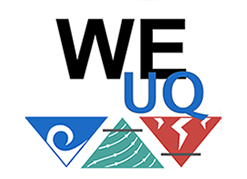

Example 4.7, Fig. 4.7.8.4.1 Visualization of the upcoming flow structure close to the ground.
The WE-UQ Application is open-source software that provides researchers a tool to assess the response of a building to wind loading. The application incorporates uncertainty quantification in the structure’s response to account for the user’s assumptions of the building properties and numerical modeling.
The latest update of WE-UQ Version 3.2.0 introduces the “Empty Domain CFD Simulation” tool. This feature enables users to run high-fidelity large-eddy simulation to characterize atmospheric boundary layer (ABL) flows. This kind of simulation is essential for calibrating boundary conditions of CFD models, thus enhancing the accuracy of subsequent wind load simulations on specific structures. The current version of WE-UQ improves the robustness of the existing CFD workflow for mesh generation, realistic boundary condition definition, and numerical solver setup. Moreover, users can monitor approaching wind characteristics, and seamlessly post-process the results on their local machines.
CFD simulations in WE-UQ run in parallel and employ OpenFOAM with additional software modules specifically tailored to wind engineering applications. To support the computational demand for these simulations, WE-UQ provides researchers with access to the TACC Frontera HPC at no cost.
A high-level, two-page overview of the WE-UQ Application can be viewed from the website.
How to cite:
Frank McKenna, Abiy Melaku, Fei Ding, Jiawei Wan, Peter Mackenzie-Helnwein, Wael Elhaddad, Michael Gardner, & Sang-ri Yi. (2024). NHERI-SimCenter/WE-UQ: Version 3.2.0 (v3.2.0). Zenodo. https://doi.org/10.5281/zenodo.10806694
Deierlein, G.G., McKenna, F., et al. (2020). A Cloud-Enabled Application Framework for Simulating Regional-Scale Impacts of Natural Hazards on the Built Environment. Frontiers in Built Environment. 6, 196. doi:10.3389/fbuil.2020.558706.